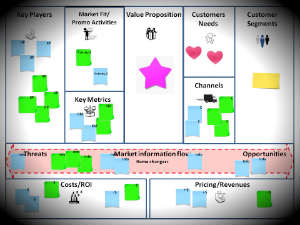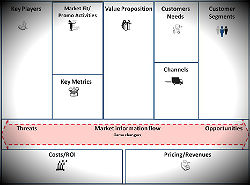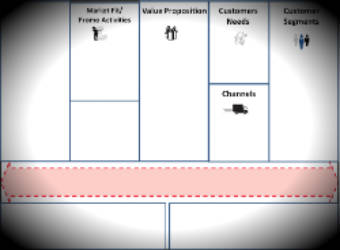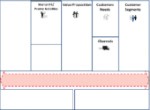
by Rita Baker | Feb 25, 2015 | Lean Startup
In previous posts (part 1, part 2 and part 3), we saw what the MVP marketing plan was about and went into details about each box. The MVP marketing plan is a quick way to plan, organise and keep track of your MVP marketing activities. These activities include any and all of the market experiments you will be doing to find your product/market fit.
Before you start filling out the boxes of the MVP Marketing plan you will need to gather some information.
Setup – First version of your MVP

If you are at your first version of your MVP then you’ll need to sit down and do a proper mini-marketing plan. The content of this plan will vary according to your type of business, your product or service and the market(s) you are going after. The basics you will need to cover are the following;
- Target market
- Who will be buying your offerings (hypotheses, customer profile, persona, etc.)?
- What are the needs of your buyers that your product or service will answer?
- How do you define your market segments?
Approximately how many customers do you realistically think will buy your offerings in each segment (what hypotheses, market information and math are you using to get to these numbers?)
- Product or service
- What is your product or service?
- How will it better answer the needs of the buyers you are aiming for than how they are satisfying their needs right now?
- Customer experience
Map out the entire experience your customers will have while interacting with your organisation and your product, or services.
At each touch point, flesh out a typical interaction. This exercise takes a while. Once you are done with it however, I guarantee you will have insights for every single aspect of your MVP marketing plan that will not only accelerate future decision making exponentially, it will enable you to make better decisions all around.
This is also where you will figure out your various customer service needs (admin. and tech.).
- Price
How much does it cost to produce each unit of product or service? Here you will calculate all of your expenditures, including any that you are not dishing out hard cash for during your calculation period but will need to eventually, and divide it by the conservative estimate of number of sales you will have during a period that makes sense for you (*). The number you get plus what you consider a reasonable profit margin should be the very lowest price you charge for your product or service. If your target market cannot bear your minimum price, you need to find a way to reduce this number before hitting the market with your MVP or find a new target market.
This is where you need to itemise all of your current and forecasted expenditures, if you haven’t done so already. Accounting can be tedious but it is essential to master it from the get go if you want your organisation to survive after your runway (**) runs out.
Forecast your sales revenues, number of sales and costs on a weekly or, at minimum, monthly basis.
- Distribution
List all of your distribution channels and the people you will be dealing with to run these channels for each MVP. If some of these channels will not be available at all times, make a calendar and sketch out which channels will be available when.
It is important to go into detail with your distribution channels. If you sell with the help of a face to face sales team (even if its friends/family who are not being paid), on the web, via your own web site, an Amazon store and via referrals on 5 other sites, you need to do the exercise for all 8 distribution channels.
Furthermore, if you use logistics suppliers (web or brick & mortar based), you need to include them in this section of your plan. They are key parts of your distribution channels and will also be impacted when you start doing promotions or marketing-communication activities.
- Promotion
Jot down ideas as to how you will get your market feedback for your next few iterations of your MVP. Also include any promotional/communication activities you will need for funding purposes. Finally, if you are anticipating any activities to get your brand out there, also include them here.
If you’re not at your first MVP iteration – Download canvas

Gather all the information described above and organise it so you, and the rest of your team, have easy access. Complete any missing information.
You can download a MVP marketing plan canvas pdf here. You can also find larger images of a canvas and a full MVP marketing plan.
Sticky notes. Sticky notes everywhere
Now that you have the basic information you need, this is the material required  to start using your MVP marketing plan
to start using your MVP marketing plan
- Poster board (22’’X28’’ or larger). Optional
- Sticky notes (as many colours as you have activities or customer segments)
- Pencil
- Brains (preferably with accompanying bodies), as many as you can gather
Draw the boxes of the MVP marketing plan on your poster board. Hang it on your office wall in an easily accessible and very visible place.
You also can draw the MVP marketing plan directly on the wall if you can stick notes on the surface.
Colour-code your marketing activities, if you will be running more than one for each MVP iteration, or your market segments (if you chose to have one board per activity), by using a same sticky note color for each of them.
Write a single idea on each sticky note. It may be hard at first to summarise your entire idea so that it will fit on one side of the sticky note. You will get very good at it with time.
If you are good at drawing, you can also draw out the idea. You can also use pictures or any other means of visual communication that you can somehow stick on your MVP marketing plan that will get the message across.
Your ideas will usually pertain to a single topic on the plan. Before you start to write your idea, you can put the initial of the box it will be stuck on in a corner of the sticky note. This will make using the notes in the future much easier and it also helps to know where to stick it back when a note falls to the ground.
If your sticky note pertains to more than one of the boxes, simply write the initials of all of the boxes the topic pertains to and stick it on the board where it makes the most sense.
Keep a supply of sticky notes and a pen near the poster board. You can even make a hole on the board, put a cord through it and hang a little pouch or plastic bag that will hold your supplies.
The more you use your MVP marketing plan, the more you will find ways to make it work for you. You will inevitably forget to put some of your ideas on the board. No worries, just stick the missing note on it when you think of it. It will usually take you less than 30 seconds to do so. Like any other management tool, it takes a certain amount of discipline to use it. Fortunately the MVP marketing plan is the management tool that requires the least amount of discipline that I know of.
Don’t throw it out
Finally, when you are done with a specific marketing activity, or you’re at your fourth layer of sticky notes on the board, put the notes in an envelope or folder clearly marked with the name of the activity as well as the weeks, month(s) and year during which the activity ran.
These notes will be very useful when you’ll need to write out a full marketing plan. It will also help you see your evolution over time or specific patterns emerging. Sometimes, it will even remind you of really good ideas you had in the past.
If you have any questions on how to use the MVP marketing plan you are welcome to contact me.
Finally, as I’ve been using this tool for my own business and with my customers it is becoming apparent that a digital version of the MVP marketing plan that would allow the following would be awesome.
- Fast recording of the visual notes (by all contributors), with an option to tie the notes to additional material
- Collaboration features that enable discussion before posting a note
- Permanent viewing/projection of a real-time board in a single or multiple locations
If you feel like this is a project you would be interested in for your own business, please contact me.
(*): If you can find average profitability margins for your sector you can go with those.
(**): A runway is the period of time a start-up has before it starts to generate sufficient revenue to cover all of its expenses.
Techno Marketing fait relâche jusqu’à la mi-mars.
Techno Marketing is taking a break until mid-March.
EDIT (Sept. 2016) – Added a link to download a pdf of the canvas

by Rita Baker | Feb 17, 2015 | Lean Startup
In the previous post of this series on the MVP marketing plan we looked at the value proposition, customer needs, customer segments, market fit/promotional activities as well as the distribution channels on the MVP marketing plan.
We will now look at the rest of the elements that compose the MVP marketing plan.
 Key players
Key players
The key players are all the actors, internal and external that will need to be involved with the marketing activity you are using the MVP plan for. This box of the plan can be used to identify the resources you will need for your marketing activity. It can also be used to keep track of the order in which key players will be needed as well as their level of involvement. Any major issues with key players that may hinder their performance or capacity to deliver can also be noted in this box. If you are familiar with project management techniques you can use a RACI (responsible, accountable, contribute or inform) designation to instantly see the relative importance of the players at any given time during the activity.
A side benefit of this box is to easily see the load on your resources so you can prioritise or re-balance workloads in order to keep delivering on time.
 Key metrics
Key metrics
The key metrics are the data points you will be collecting and analysing to ensure that you are reaching the goals you have set for specific marketing activities. A key metric can be anything from analytics data to survey answers or observations you have noted. In the Lean Startup methodology key metrics are the heart of the measure part of the Build – Measure – Learn triad.
In traditional marketing, it’s the control part of marketing management. It is what tells you if you are going forward, backwards or sideways relative to your goals. Without it, you are blind to any progress or missteps. If a significant portion of your goals pertains to web activities, web analytics data will be the major (if not only) source of your key metrics. If this is your situation and you don’t have the internal expertise to gather and analyse web analytics data, I urge you to get external help while you crash learn about it.
 Pricing and Revenues
Pricing and Revenues
This is where you look at your pricing strategy for your marketing activity and the revenues you anticipate from it. Although the revenues from marketing activities are not always hard cash coming into the till, they should always be converted in $ (or whatever your local currency is). This, so you can figure out the return on your investments from the marketing activity you undertook. You will also need to compare your activities in term of ROI and see which types are the most valuable.
If your marketing activity impacts your pricing (discounts, promotional prices, new price category is created, etc.) this box will allow you to keep track of your pricing strategy and help you avoid, ‘’boxing yourself into a corner’’ price-wise, or other pricing issues that can creep up when your do multiple promotional activities that impact your pricing.
 Costs/ROI
Costs/ROI
This is the financial part of your marketing activity. You need to look at all the costs involved and compare them to the revenues expected to figure out your return on investment (ROI). The ROI is what will tell you whether or not you should go forward with your activity. Just like any other project, a marketing activity should never be undertaken if you don’t expect it to be profitable. It’s normal to not be good at forecasting your costs and revenues at first as you don’t have experience. It is essential that you keep at it and learn. Otherwise your marketing expenses can become a budgetary black hole that will engulf your entire business. On the flip side you can become so traumatised by allocating marketing budgets and never seeing returns that you will cease all marketing activities. In either case the end results will be deadly to your business.
Comparing the ROI from one activity to the next can also help you prioritise and spot the types of activities that are the most profitable for your business. In order to use this box in such a way, you will need to update your ROI information once your activity is completed as your real costs and revenues will differ from the projected ones you used to decide whether the activity was a go or no go.
Market Information Flow
This element is one of the more innovative aspects of the MVP marketing plan. Although every business knows market information is needed to operate, most of them do not realise the importance of allocating permanent resources to collect, analyse and diffuse information throughout the company. If you are going to operate in a fast moving market, (most markets that are not heavily regulated or deal with extremely high priced goods or services now fit this category) you will need to have your ear to the ground to hear threats, opportunities and changes in your customers’ need coming. A failure to see any of this can result in death or near death experiences for your business.
Businesses have always collected market information. It was usually the responsibility of the marketing team. The internet has since made the amount of available market information so huge that it is impossible for only a few people to gather, filter and use the pertinent information. This is why the market information conduit must go through every department in a company, ideally in real-time. Every single resource must be a gatherer and a user of market information as it pertains to their main task.
In the context of the MVP marketing plan, the market information flow element serves as a bulletin board where anyone who gets wind of information that could affect any aspect of the marketing activity itself can bring it forward so the adjustments can be made.
In the end, the market information flow box represents what being an entrepreneur is all about. You make a plan, shit happens and you have to deal with it quickly. In more elegant terms, being a successful entrepreneur is more about how fast you learn and react to those learnings than what you already know.
In our fourth and final post of this series we will take a look at ways to use the MVP marketing plan.
EDIT – Sept 2016 – Link fixes and pictures

by Rita Baker | Feb 10, 2015 | Lean Startup
In the previous post I went over what the Minimum Viable Product marketing (MVP) plan can do for your company. Now, I will share with you the elements that are part of the MVP marketing plan.
The MVP marketing plan takes its inspiration from the Business Model Generation (BMG) canvas as well as Lean Startup methodology. It uses the canvas form of the BMG and shares some of the same elements. It is also used the same way with little sticky notes (texts or pictograms) to remind you of what you discussed with your team.
Each iteration of your MVP will require adjustments to your MVP marketing plan. Of course, the first one will be the longest to build as you will be starting from scratch.
Value Proposition
Your value proposition is defined as the benefits your customers can expect from your product or service. It is the heart of your marketing plan. Your value proposition will state how your customers will maximise their gains, minimise their pains and do their jobs (literally or figuratively) better with your product or service. Writing your value proposition is not always an easy task. If you are having a hard time with it I strongly suggest you take a look at Value Proposition Design from the authors of BMG.

 Customers Needs
Customers Needs
Identifying the customers’ needs, you are answering with your MVP, is essential to writing your value proposition. It is also normal and positive to refine your understanding of your customer needs from one plan iteration to the next. Your new findings will most likely impact most if not all of the other elements of the plan. This previous Techno Marketing blog post on understanding your customer needs can help.
 Customer Segments
Customer Segments
Your MVP marketing plan may be addressing one, a few, or all of your customer segments. The assumption here is that you have already identified the segments your business will be pursuing. Customer segmentation can be just as difficult, if not more, than writing your value proposition. There are hundreds if not thousands of marketing books that will try to teach you how to go about segmentation. Taken to its limits it is a science. However, if you are just starting up and marketing isn’t your thing, here is a little recipe that will help you get started with your segmentation. When you go out and talk to people, you assume will be interested by your product or service, put them into 3 groups:
- Super excited about your product and want to buy it right now
- Are interested in your product and want more information
- Listened to you politely, told you your idea was great and wished you luck
Discard the folks in groups 2 and 3 as well as the ones who told you to go fly a kite for this exercise. Analyse all the information you wrote down as well as the one you remember from your meetings with people in group 1. You will need at least 5-6 subjects in group 1 in order to segment (*). Try to find commonalities among a few of the subjects or characteristics that differentiate them from each other. The commonalities or characteristics could be
- How important certain of the pains you are trying to ease are to them
- How much value they place on the gains your product offers them
- How they go about doing the job you want to facilitate on a daily basis
Just remember you will be forming segments with these variables in the future. Hence you want them to be as easily measurable and identifiable as possible.
 Market fit and/or promotional activities
Market fit and/or promotional activities
This element of the plan includes different types of activities. If you are ready to start selling your product (even in pre-order mode) you will need to promote your company and product to do so. Your ‘’marketing team’’ will think of some promotional activities for each segment and this element is where you will keep track of what is going on at a given time. If you are not yet selling but you are either promoting your brand (maybe with potential VCs), elaborating a Kickstarter campaign, or doing some other promotional activity to get your product or product idea out in front of potential customers, this is also where you will keep track of those activities.
 Channels
Channels
This element identifies the distribution channels that will be impacted by your promotional activities. Whether it be the web, your sales reps or point of sales this element will help you keep track of who and how they will be impacted as well as any actions required with the channels due to your promotional activities.
The third post in this series will cover the five remaining elements of the MVP marketing plan.
(*) If you don’t have at least 5 persons in group 1, try with people that have a different profile or get someone who can communicate the value proposition better. If you have looked high and low and can’t find 5 persons excited about your product, abandon ship and try again with a different product/service idea.
EDIT – Sept. 2016 – Graphics

by Rita Baker | Feb 3, 2015 | Lean Startup
As I’m gaining experience helping companies market their minimum viable products (MVP) it is quite clear that the traditional marketing plan isn’t suited for the task.
Those of you who have read me in the past know I am a big fan of Business Model Generation, Lean Startup (hence the MVP) and Design Thinking for fast moving business environments.
I have looked at various marketing plan models that somewhat followed those lines of thinking. I tried using Ash Maurya’s Lean Canvas (based on the Business Model Generation canvas), which seemed like the better alternative, but it’s still not exactly what my clients needed to organise their marketing efforts. Hence I found myself adding boxes and crossing others out on the canvas according to my customer’s needs.
After almost a year, I am on my way to a marketing plan canvas that
- Lets the user cover all the marketing bases – it also acts as a checklist
- Allows a full view of what is currently going on marketing-wise
- Is easy to work with (as most users don’t have a marketing background)
- Minimises time investment in planning
- Can be adapted for different environments and situations
This canvas is not final. I don’t think it will ever be final. As it is more of an open toolbox than a tool, it will be used differently for different jobs. It will also be used differently by different people for the same job. As with the Business Model Generation canvas on which it is based, the innovation of the MVP marketing plan doesn’t come from the concepts it contains but rather an organisation of tried and true marketing concepts to better suit the realities of today’s start ups.
 Who has time for a marketing plan?
Who has time for a marketing plan?
Inherent to the Lean Startup methodology of MVPs is the break-neck speeds at which activities need to get done. In such environments it’s very easy to dismiss planning as a waste of time.
I won’t extol the virtues of business planning in this post as I’m certain you have heard them all. I will however share with you the benefits of a marketing plan when dealing specifically with MVPs that I have observed when helping start-ups.
Benefits of a marketing plan for a MVP
 Covering your bases
Covering your bases
Often early stages start-ups don’t have marketers to help them commercialise their MVPs and the marketing that needs to be done is not always clear. The MVP marketing plan can serve as a guide or check list to ensure the marketing bases have been covered. It doesn’t by any means replace deep marketing knowledge or a full marketing plan. It can however reassure you that you are not completely in left field when it comes to getting your MVP to market.

 A visible reminder and beacon
A visible reminder and beacon
The MVP marketing plan will be on the wall in your start-up space. You will be reminded every time you look at it of the what, when, where, why and how of your MVP every day. This helps with your focus as well as accelerates decision making when it comes to the MVP issues.
Some days, ok who am I kidding every day, entrepreneurs’ head spin with the sheer amount of information they have to process, issues they have to deal with, people they have to convince and decisions they need to make. It is very easy to lose sight of why you are launching your product and who you are doing it for.
The MVP marketing plan acts as a beacon to help you get back on the right track when you don’t know which way is up any longer.
 Gaining new understandings by changing your point of view
Gaining new understandings by changing your point of view
An entrepreneurial team I worked with who were at a standstill at their 4th MVP iteration found a new use for the MVP marketing plan. They chronologically aligned all their post-its (used in the multiple MVP marketing plan iterations they went through in 6 months) in each box in the plan. Simply by reorganising the display of this information they quickly identified a subtle shift in marketing strategy, which had gone unnoticed, after the onboarding of a new resource in the company. This shift had sent them on a wrong path on their 4th MVP iteration.
It also allowed them to realise that the recent delays they were experiencing on their schedule was due to a key resource that was not the one they had initially identified as the culprit.
Finally, as I walked by their reorganised MVP plan I was able to see that they had incorporated a few vanity metrics in their last MVP iteration. When I asked them why, they humbly admitted that with their last MVP iteration not doing as well as previous ones they used these metrics to boost their moral and that of their surroundings. Some soul searching ensued.
In the second post of this series, I will show you what the MVP marketing plan canvas looks like and how to use it.
EDIT Sept. 2016 – Graphics

 to start using your MVP marketing plan
to start using your MVP marketing plan



 Key players
Key players Pricing and Revenues
Pricing and Revenues Costs/ROI
Costs/ROI

 Customers Needs
Customers Needs Market fit and/or promotional activities
Market fit and/or promotional activities
 Who has time for a marketing plan?
Who has time for a marketing plan? Covering your bases
Covering your bases
 A visible reminder and beacon
A visible reminder and beacon Gaining new understandings by changing your point of view
Gaining new understandings by changing your point of view